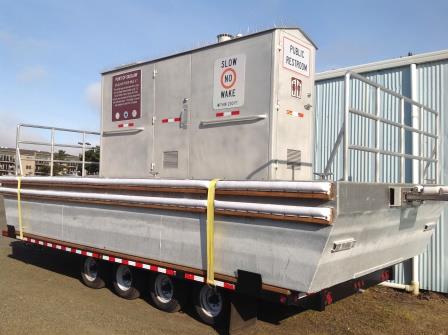
A floating restroom has three main components: barge, superstructure, and toilet system. The primary material used is marine-grade aluminum because of its durability, corrosion resistance, longevity, and recyclability. The barge is a structurally stable platform supporting the superstructure with the toilet system.
The barge is approximately 24 feet long, 11.5 feet wide, and 3.5 feet deep and is divided into seven watertight compartments. The four corner compartments have foam flotation. The two, side compartments (ballast tanks) are filled with water once the floating restroom is anchored in place. Each ballast tank holds 1200 gallons. Adding water ballast:
- lowers the unit into the water
- reduces the freeboard
- greatly increases the stability of the floating restroom
The center compartment is a double-walled 1200-gallon sewage holding tank.
The superstructure is approximately 14 feet long, 3.5 feet wide, and 7.5 feet high and is divided into three compartments. The superstructure is centered on the barge and provides ample access on all sides. The two end compartments are restrooms, and each contains a flush toilet and urinal. The center compartment has a mechanical room, containing:
- the toilet flushing equipment
- water ballast pump
- low voltage power system
- tank monitoring system
- storage and access to the sewage holding tank
Skylights are on the roof of the superstructure toilet compartment. There are vents for all three compartments, a solar panel, a mooring light, and a sewage holding tank vent pipe. The doors have vents, privacy locks, and power closers. Both sides of the superstructure have grab bars and are on three walls of the toilet rooms. Full-width guardrails are located at each end of the floating restroom. The superstructure and barge deck have a non-glare and non-slip surface.
The toilet system has two stainless steel flush toilets, button-activated flush valves, a water pump, and a water holding tank. The pump supplies fresh water to a 13-gallon holding tank which meters out about 1/2 gallon per flush. Waste goes directly into the sewage holding tank after each flush. A special valve in the toilet bowl closes after each flush keeping a small amount of water in the bowl.
Floating restrooms are towed to a location and anchored in place by piling or a cabling system. When the holding tank is full, the floating restroom is towed to shore and pumped out by a commercial sanitation service.




